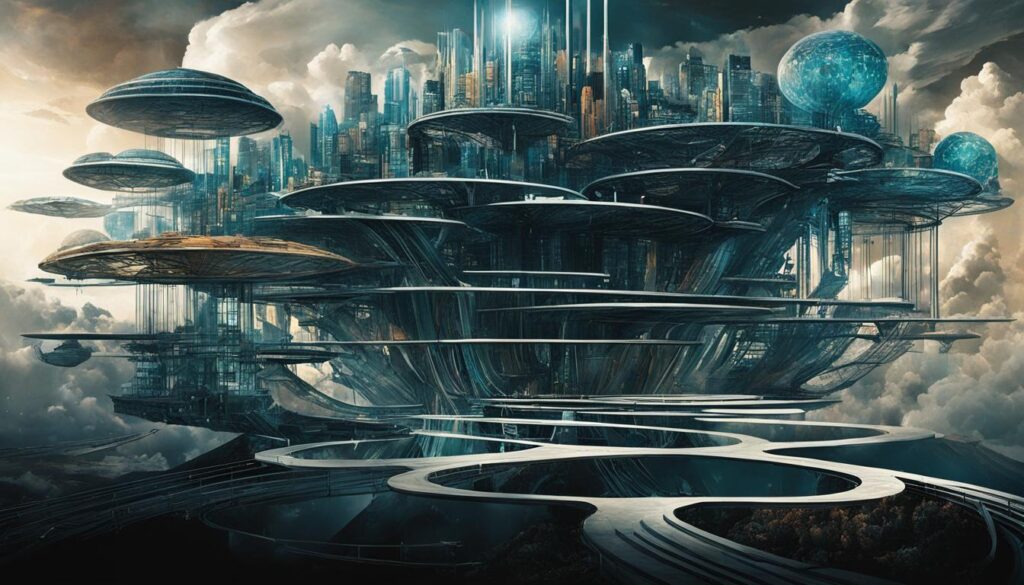“Cloud Atlas” by David Mitchell is a critically acclaimed novel that has mesmerized readers since its publication in 2004. In this audiobook review, we explore the imaginative world and captivating narrative of this literary masterpiece. David Mitchell, the award-winning author, weaves a complex and interconnected story that spans across time and space. This review delves into the elements of the audiobook production, the plot summary, character analysis, themes and symbolism, critical reception, and more. Follow us on this journey as we unravel the intricate details of this enthralling book.
Overview of “Cloud Atlas”
David Mitchell’s “Cloud Atlas” is a monumental novel that explores the interconnectedness of human lives across time and space. Published in 2004, the book weaves together six different narratives, each set in a different era, ranging from the 19th century to a post-apocalyptic future.
The novel’s themes include the cyclical nature of history, the power of storytelling, and the inevitability of change. One of the most remarkable aspects of the book is the way in which Mitchell combines different genres, including historical fiction, science fiction, and even crime thriller.
The characters in the novel are diverse and complex, from Adam Ewing, a 19th-century American notary, to Sonmi-451, a genetically engineered servant in a dystopian future. Each character is connected to the others in surprising and unexpected ways, providing a rich and immersive reading experience.
The novel’s structure is also noteworthy, as Mitchell uses a unique narrative technique that involves interrupting each story at a climactic moment before moving on to the next one. This creates a sense of anticipation and tension that keeps the reader engaged throughout the book.
Overall, “Cloud Atlas” is a tour de force of literary storytelling that has cemented David Mitchell’s reputation as one of the most innovative and imaginative writers working today.
Key Information about “Cloud Atlas”
| Author | David Mitchell |
|---|---|
| Published | 2004 |
| Genre | Historical fiction, Science fiction, Postmodern literature |
| Themes | Interconnectedness, History, Storytelling, Change, Technology |
| Main Characters | Adam Ewing, Robert Frobisher, Luisa Rey, Timothy Cavendish, Sonmi-451, Zachry |
| Structure | Interconnected stories interrupted at climactic moments |
Audiobook Production
When it comes to creating an audiobook, many factors come into play. For “Cloud Atlas,” the audiobook production team ensured that the audio experience would do justice to the imaginative and complex narrative of the novel.
The narration quality is a crucial aspect of an audiobook, and in this case, the production team opted for a skilled narrator to bring the story to life. John Lee, a seasoned voice actor, takes on the task of narrating the novel, delivering a nuanced performance that captures the essence of each character.
The audio experience itself is also noteworthy, with a seamless transition between different parts of the novel, thanks to the recording and editing techniques. The sound effects and music complement the story, immersing the listener in the world of “Cloud Atlas.”
Overall, the audiobook production of “Cloud Atlas” achieved a high standard, elevating the audio experience and providing an engaging alternative to reading the print version.
Plot Summary
David Mitchell’s “Cloud Atlas” is a profound literary work that tells six interconnected stories across different time periods and settings. These stories are not told in a linear fashion, rather they are woven together, unfolding one after another, until they are finally resolved in reverse order. The novel portrays the interconnectedness of humanity and the cyclical nature of human history.
The first story is set in the Pacific Islands in 1850, where a young American notary named Adam Ewing finds himself on a voyage home to San Francisco. The second story is set in 1931, where a penniless musician, Robert Frobisher, travels to Belgium to work as an amanuensis for a famous composer. The third story is set in 1975, where a persistent journalist named Luisa Rey uncovers a hidden conspiracy involving a nuclear power plant. The fourth story is set in present-day England, following the trials of aging publisher Timothy Cavendish, who finds himself confined to a nursing home he cannot escape. The fifth story is set in the future, in the dystopian city of Neo So Corpos, where a cloned “fabricant” named Sonmi-451 becomes conscious of her servitude. The last story is set in a distant post-apocalyptic future, where humanity has regressed to a primitive, tribal society.
The narrative structure of “Cloud Atlas” is complex and intricate, with each story serving as a bookmark for the story that follows. This nonlinear structure enhances the themes of the novel, highlighting the cyclical nature of human history and the interdependence of individual choices. Mitchell’s portrayal of the human condition is both thought-provoking and imaginative, challenging readers to reflect upon their roles in the grand scheme of things.
Character Analysis
David Mitchell’s “Cloud Atlas” features a diverse cast of characters, each with their own unique struggles and motivations. Through a series of interconnected stories, Mitchell explores the complexities of human nature and the impact our actions have on ourselves and others.
The protagonist of the novel, Adam Ewing, is a young American notary who becomes embroiled in a web of deceit and conspiracy during a voyage to the South Pacific in the mid-19th century. Through his journey, Ewing is forced to confront his own prejudices and limitations, ultimately leading to personal growth and understanding.
On the other end of the spectrum is the antagonist of the novel, Nurse Noakes. A sadistic figure, Noakes represents the darker side of human nature, using her power to manipulate and control those around her for her own gain. Through her character, Mitchell examines the harm that can be inflicted on others when power is left unchecked.

Other Key Characters
| Name | Description |
|---|---|
| Robert Frobisher | A talented but troubled young composer, Frobisher seeks inspiration and validation while working as an amanuensis for an elderly musician in the early 20th century. |
| Luisa Rey | An investigative journalist in the late 20th century, Rey’s determination and bravery put her in danger as she uncovers a dangerous conspiracy in the nuclear power industry. |
| Timothy Cavendish | A vain and self-centered publisher in the present day, Cavendish’s misfortunes and run-ins with the law are both humorous and thought-provoking. |
| Sonmi-451 | A genetically-engineered clone in a dystopian future, Sonmi-451 becomes a symbol of hope and rebellion for the underclass as she fights against the oppressive government. |
As we analyze each character’s journey throughout “Cloud Atlas,” it becomes clear that Mitchell seeks to underscore the universal struggles and strengths of humanity. Each character’s story is threaded together by the novel’s overarching themes of interconnectedness, empathy, and the power of choice, making for a compelling and thought-provoking read.
Themes and Symbolism
In “Cloud Atlas,” David Mitchell masterfully weaves together various themes and symbols, creating a rich, multilayered narrative. One of the prominent themes is the cyclical nature of time, where the past, present, and future converge, blurring the boundaries between them. Mitchell employs different literary techniques, such as parallelism, repetition, and foreshadowing, to reinforce this theme and imbue the narrative with a sense of inevitability.
The motif of interconnectedness is also prevalent throughout the book. The six seemingly disparate stories are intricately interconnected, highlighting the idea that our actions and choices ripple across time and space, affecting not only ourselves but others as well. Mitchell’s use of different genres and styles in each story underscores this idea, emphasizing the diversity and depth of human experience.
Moreover, “Cloud Atlas” explores the themes of power, oppression, and resistance, portraying how individuals and societies are shaped by their circumstances and how they choose to respond to them. Mitchell’s nuanced characterizations add layers of complexity to each story, forcing readers to grapple with the moral ambiguity of human nature. The book is ripe for literary analysis, offering readers an opportunity to contemplate the deeper meanings and implications of Mitchell’s writing.
Writing Style
David Mitchell’s writing style in “Cloud Atlas” is a masterclass in narrative technique. He employs several distinct styles and voices throughout the novel, each suited to the specific story and time period it represents. The result is a complex and immersive reading experience that transports readers through time and space.
Mitchell’s language is rich and poetic, elevating even the most mundane details to the level of artistry. He uses vivid imagery and metaphors to bring his scenes to life and create a vivid sense of place. At the same time, his writing remains grounded and accessible, never veering into pretentiousness or obfuscation.
The structure of the novel is also noteworthy, with six distinct but interconnected stories woven together in a mesmerizing tapestry. Mitchell’s use of foreshadowing and callbacks creates a sense of unity and coherence despite the disparate narratives, highlighting the themes of connectedness and interdependence that underpin the novel.
Critical Reception
“Cloud Atlas” has received widespread critical acclaim from literary circles, earning numerous book awards and accolades since its publication in 2004. Reviewers have praised David Mitchell’s ambitious narrative structure, intricate plotlines, and unique writing style that seamlessly blends genres.
The novel was shortlisted for the prestigious Booker Prize and the Nebula Award for Best Novel. In 2009, “Cloud Atlas” was included on The Guardian’s list of the 100 best novels ever written and has since been translated into more than 30 languages.
Book reviews have described “Cloud Atlas” as a “tour de force,” “a work of genius,” and “an ambitious, finely wrought masterpiece.” Critics have praised Mitchell’s ability to seamlessly weave together an interconnected narrative that spans across time and space, each story building upon the last in a mesmerizing and unforgettable reading experience.
“Cloud Atlas is that rare thing in contemporary fiction: a sacred text…It is a work of art, and] is genuinely innovative in both form and execution. David Mitchell, who must surely be one of the most exciting novelists writing in English today, has shown himself to be the literary equivalent of a David Bowie, or an equivalent chameleon, willing to change and adapt his voice, characters and style to tackle a kaleidoscopic range of subjects…The trials that Mitchell puts his readers through are frequently immense, but never gratuitous. We are fortified through the experience of this book, and emerge as its champions and guardians.”
Comparison to the Film Adaptation
After its publication, “Cloud Atlas” garnered attention from Hollywood, leading to the release of a film adaptation in 2012, directed by the Wachowski siblings and Tom Tykwer. While the movie received mixed reviews, it still offered a visually stunning interpretation of the novel.
One of the most significant differences between the film adaptation and the book is in the narrative structure. Whereas the book alternates between six different storylines, the film intertwines them to create a more straightforward narrative. This decision, while perhaps necessary for a film adaptation, could take away from the intricate and interconnected nature of the novel.
Another point of comparison is the portrayal of characters. While the movie’s cast, which includes Tom Hanks, Halle Berry, and Hugh Grant, delivers noteworthy performances, some critics argued that they failed to capture the depth and complexity of the book’s characters.
Despite these differences, the film adaptation of “Cloud Atlas” still manages to capture the essence of the book and convey its overarching themes. For those who enjoyed the book, the movie offers a poignant visual representation of the intricate storytelling and imaginative world-building by David Mitchell.

“The movie manages to tell multiple stories within a unified arc, but it does so leaving out characters, scenes, themes, and relocating the stories of others. It’s flawed but impressive, worth watching once and thinking about after.” – Roger Ebert, movie critic
Impact and Legacy
Since its publication in 2004, “Cloud Atlas” has had a significant impact on the literary world. David Mitchell’s epic novel has been praised for its imaginative storytelling, intricate structure, and thought-provoking themes.
The novel’s legacy includes numerous awards and accolades, including being shortlisted for the Man Booker Prize. It has also been translated into over 30 languages, reaching readers all around the globe.
One of the most significant impacts of “Cloud Atlas” has been its influence on other works of literature. Mitchell’s complex narrative structure and interwoven storylines have inspired other authors to experiment with form and structure in their own writing.
“Cloud Atlas is as astonishingly bold a meditation on the fate of civilization as it is engaging for the narrative heft of Mitchell’s prose.” – Boston Globe
The novel’s themes of interconnectedness and the cyclical nature of humanity continue to resonate with readers. “Cloud Atlas” has become a modern classic, cementing its place in contemporary literature and inspiring future generations of writers.
Reader Recommendations
If you enjoyed “Cloud Atlas” by David Mitchell, here are our top recommendations for similar novels and other works that may pique your interest:
| Title | Author | Description |
|---|---|---|
| The Bone Clocks | David Mitchell | A kaleidoscopic novel that weaves together six interconnected narratives spanning decades and continents. |
| The Time Traveler’s Wife | Audrey Niffenegger | A mesmerizing love story that transcends time and space, exploring the power of fate and free will. |
| The Fifth Season | N.K. Jemisin | A groundbreaking fantasy novel that introduces a world ravaged by environmental cataclysms and follows the journey of three women with extraordinary powers. |
More Works by David Mitchell
David Mitchell has penned several other acclaimed works that showcase his unique storytelling and writing style. Check out these titles:
- Ghostwritten
- number9dream
- Black Swan Green
- The Thousand Autumns of Jacob de Zoet
Audiobook Review
David Mitchell’s “Cloud Atlas” is a critically acclaimed novel that captivates readers with its intricate plot, diverse characters, and thought-provoking themes. The audiobook adaptation does not disappoint and enhances the overall reading experience with its narration quality and pacing.
The narration by various voice actors adds depth to each character’s individual storyline, providing a nuanced and engaging performance that keeps listeners hooked. The pacing is well-balanced, allowing the story to unfold gracefully without sacrificing excitement or momentum.
The audio adaptation successfully translates Mitchell’s intricate and imaginative writing style to an auditory format, allowing listeners to fully immerse themselves in the story’s intricacies.
“The audiobook adaptation of ‘Cloud Atlas’ is a triumph in narrative performance and audio production, bringing Mitchell’s work to life with skill and artistry.”
Conclusion
After exploring “Cloud Atlas” by David Mitchell in audiobook form, it’s clear that this novel is a masterpiece of imaginative storytelling. The audiobook production brings the characters and their stories to life, enhancing the already captivating narrative.
The novel’s structure is complex yet rewarding, with interconnected stories that span time and space. The characters are richly developed, with their motivations and conflicts adding layers of depth to the novel.
David Mitchell’s writing style is unique and masterful, employing narrative techniques, language, and structure that contribute to the overall reading experience.
The critical reception of “Cloud Atlas” has been overwhelmingly positive, and its impact on contemporary literature is undeniable.
For those who enjoyed “Cloud Atlas,” there are plenty of other works by David Mitchell that are worth exploring.
Overall, the “Cloud Atlas” audiobook is a must-listen for fans of imaginative storytelling, complex characters, and thought-provoking themes.
Final thoughts? Give this audiobook a listen and be transported to the imaginative world that David Mitchell has created.



